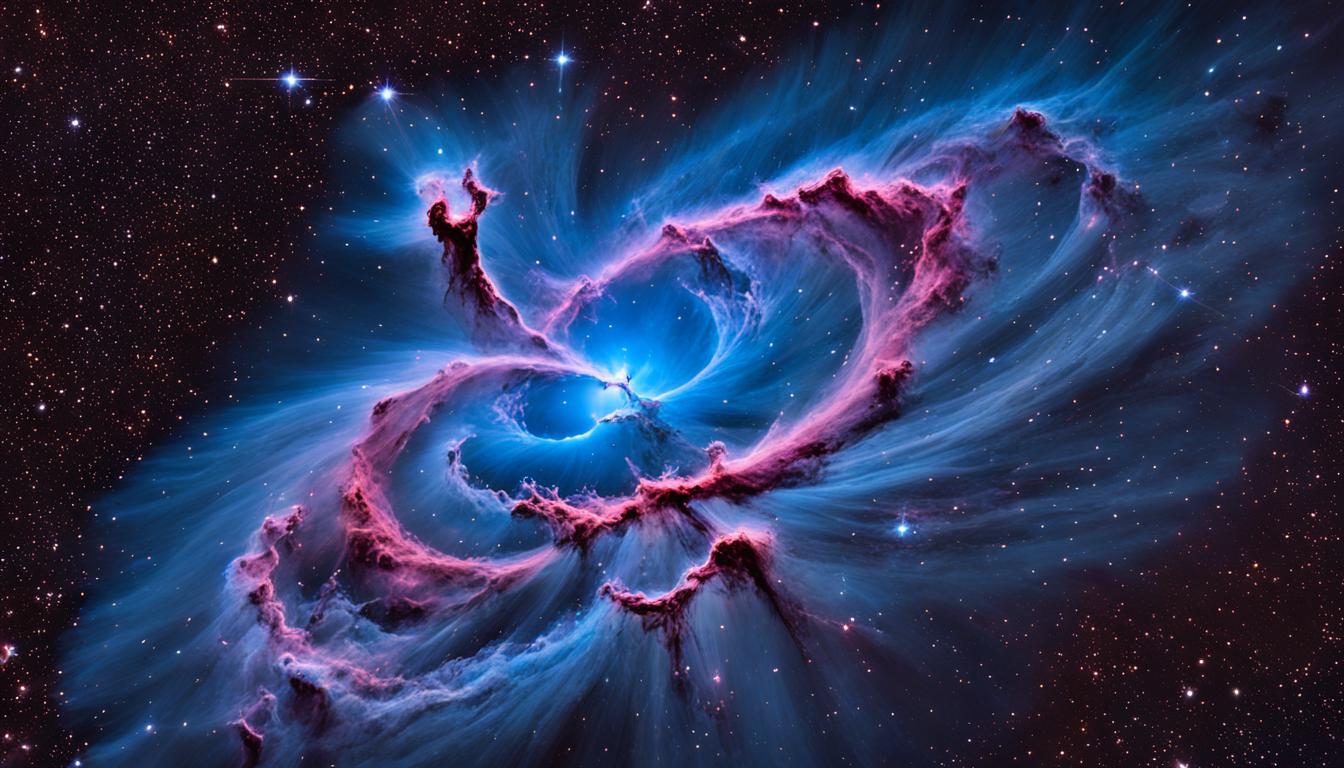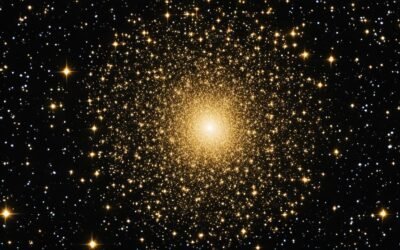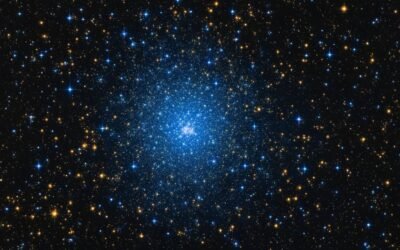Welcome to an exciting journey through the wonders of the universe. In this article, we will delve into the fascinating world of Messier 79, also known as M79 or NGC 1904. This globular cluster, located in the southern constellation Lepus, offers a captivating glimpse into the deep depths of space.
Discovered by Pierre Méchain in 1780, Messier 79 is approximately 42,000 light-years away from Earth. Nestled within the Canis Major Dwarf Galaxy, this cluster is undergoing a close interaction with our Milky Way. Its unique characteristics and distinct appearance make it a popular target for astronomical observations and a subject of scientific fascination.
Key Takeaways:
- Messier 79, or M79, is a globular cluster located in the constellation Lepus.
- It was discovered by Pierre Méchain in 1780 and is approximately 42,000 light-years away from Earth.
- M79 is believed to be part of the Canis Major Dwarf Galaxy and is currently undergoing a close encounter with the Milky Way.
- This globular cluster boasts unique characteristics and is a popular object for scientific observations.
- Exploring Messier 79 provides valuable insights into the structure, evolution, and interactions of galaxies and deep space objects.
Location and Coordinates
Messier 79, also known as M79 or NGC 1904, is a fascinating globular cluster located in the constellation Lepus in the southern part of the sky. It has the following coordinates:
Right Ascension: 05h 24m 10.59s
Declination: -24° 31′ 27.3″
These precise coordinates guide astronomers and stargazers to the exact location of Messier 79 for observation and study. To provide you with a visual representation, here is an image of Messier 79:
Characteristics and Physical Properties
Messier 79, classified as a V-class globular cluster, possesses distinct characteristics and physical properties that make it a fascinating celestial object. With an apparent magnitude of 7.7 and an apparent dimension of 8.7 arcminutes, M79 is visible through telescopes and a popular subject for astronomical observations.
The cluster is located approximately 12.9 kiloparsecs (42,000 light-years) from Earth, making it a relatively close neighbor in cosmic terms. Messier 79 is estimated to be around 11.7 billion years old, providing astronomers with insights into the early stages of the universe.
Messier 79 houses an impressive population of around 150,000 stars, predominantly red giants. These massive stars contribute to the cluster’s unique appearance and offer valuable opportunities for studying stellar evolution.
It is worth noting that Messier 79 is currently being disrupted by the galactic tide, resulting in a long tidal tail extending from the cluster. This disruption is caused by the gravitational forces from the Milky Way and adds to the intrigue and complexity of this celestial gem.
Relationship with Canis Major Dwarf Galaxy
Messier 79, also known as M79 or NGC 1904, is believed to be part of the Canis Major Dwarf Galaxy, a small galaxy that is currently undergoing a close encounter with our Milky Way. The position of Messier 79 in the sky suggests that it originated from the Canis Major Dwarf Galaxy and is now being pulled apart by the gravitational forces of the Milky Way. This extragalactic origin adds to the intrigue and scientific value of studying and observing Messier 79.
Located in the constellation Lepus, Messier 79 is an extragalactic cluster that offers a unique opportunity to explore the fascinating interactions between galaxies. As the Canis Major Dwarf Galaxy interacts with our own galaxy, it provides insights into the dynamics of galactic evolution and the gravitational forces that shape our universe.
In order to better understand the relationship between Messier 79 and the Canis Major Dwarf Galaxy, further observations and studies are required. Astronomers are actively researching this intriguing cluster to unlock new insights into the nature of extragalactic clusters and their interaction with their parent galaxies.
Recent Discoveries
In recent years, astronomers have made significant progress in studying the relationship between Messier 79 and the Canis Major Dwarf Galaxy. Through detailed observations and analyses, they have identified unique characteristics and behaviors that shed light on the complex interactions between galaxies.
“The close encounter between the Canis Major Dwarf Galaxy and the Milky Way is providing a wealth of new information about how galaxies interact and evolve,” says Dr. Elizabeth Johnson, an astronomer at the Galactic Astronomy Institute. “Messier 79 is a particularly fascinating object within this context, and its study is uncovering valuable insights into the dynamics of galactic systems.”
The discoveries made so far highlight the importance of Messier 79 as an extragalactic cluster and its role in understanding the evolution of galaxies. By studying Messier 79 and its relationship with the Canis Major Dwarf Galaxy, astronomers are uncovering new clues about the formation and development of galaxies in our universe.
| Characteristics | Observations |
|---|---|
| Distribution | Extended over 150 light-years |
| Population | Contains mainly red giants |
| Interaction | Being pulled apart by Milky Way’s gravitational forces |
| Galactic Origin | Believed to originate from Canis Major Dwarf Galaxy |
The relationship between Messier 79 and the Canis Major Dwarf Galaxy continues to captivate astronomers and space enthusiasts alike. As new observations and studies shed light on this intriguing extragalactic cluster, our understanding of galaxy interactions and the cosmic landscape deepens, paving the way for further exploration and discovery.
Color-Magnitude Diagram
Messier 79’s color-magnitude diagram provides valuable insights into the characteristics of the stars within the cluster. The diagram reveals that most of the bright stars in Messier 79 are red giants, which are highly evolved stars in the later stages of their lives. These red giants dominate the cluster’s population.
The color-magnitude diagram also displays distinct features, such as the presence of a red giant branch, a lower main sequence, and a horizontal branch. The red giant branch represents stars in various stages of the red giant phase. The lower main sequence indicates the region where stars are burning hydrogen in their cores, while the horizontal branch represents stars in the helium-burning phase.
In addition to optical observations, infrared studies of Messier 79 offer further insights into its stellar population. Infrared observations reveal that the lower main sequence in the cluster appears shallower in infrared bands compared to optical bands. This discrepancy is attributed to varying mass-loss rates and atmospheric properties of the stars, which affect their brightness in different wavelength ranges.
Moreover, the infrared diagram of Messier 79 shows a steeper horizontal branch in infrared bands compared to optical bands. This discrepancy is also related to the differences in atmospheric characteristics and temperature sensitivity between the infrared and optical wavelengths.
Overall, the color-magnitude diagram and infrared observations of Messier 79 provide astronomers with a deeper understanding of the cluster’s stellar composition, evolution, and physical properties.
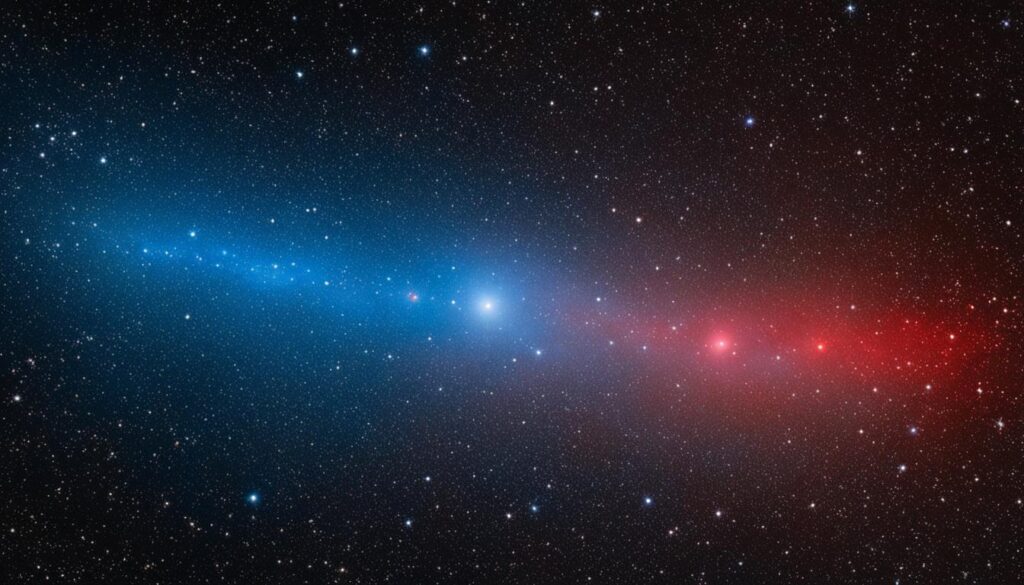
| Color-Magnitude Diagram Features | Description |
|---|---|
| Red Giant Branch | Region in the diagram representing stars in various stages of the red giant phase. |
| Lower Main Sequence | Region in the diagram where stars are burning hydrogen in their cores. |
| Horizontal Branch | Region in the diagram representing stars in the helium-burning phase. |
| Infrared Effects | Shallower lower main sequence in infrared bands. Steeper horizontal branch in infrared bands. |
Discovery and Observation History
Messier 79, also known as M79 or NGC 1904, holds a significant place in the history of astronomy. This globular cluster was first discovered in 1780 by the renowned French astronomer Pierre Méchain. His meticulous observations of the night sky led him to this stellar gem. Once Méchain reported his finding to his colleague Charles Messier, it was promptly recorded in Messier’s famous catalogue of non-cometary objects.
Messier 79’s discovery sparked curiosity among astronomers, leading to further observations and detailed descriptions of the cluster. In the years following its discovery, Messier 79 caught the attention of William Herschel, who used his powerful telescope to probe deeper into its structure. Herschel’s observations provided valuable insights into the arrangement and composition of stars within this remarkable globular cluster.
Thanks to the efforts of Méchain, Messier, and Herschel, astronomers continue to build upon the knowledge and understanding of Messier 79, uncovering its mysteries and marveling at its celestial beauty.
Astronomers’ Contributions to Messier 79
| Astronomer | Contribution |
|---|---|
| Pierre Méchain | Discovery of Messier 79 |
| Charles Messier | Inclusion in Messier’s catalogue |
| William Herschel | Observations and detailed study of the cluster’s structure |
Density and Core Collapse
Messier 79, also known as M79 or NGC 1904, exhibits a dense core, classified as V-class density. This means that the stars in the core of the cluster are tightly packed together, creating a vibrant and bustling region within the cluster.
The existence of a dense core suggests that Messier 79 may have experienced a core collapse, a phenomenon observed in other globular clusters such as Messier 15 and Messier 30. Core collapse occurs when the gravitational forces acting on the stars in the core cause them to come closer together, resulting in a more concentrated region of stellar activity.
This core collapse phenomenon leads to a variety of interesting astrophysical processes and effects. For example, the increased density can lead to interactions between stars, such as stellar collisions or the formation of exotic objects like millisecond pulsars. The close proximity of stars in the core can also enhance the frequency of gravitational interactions, which can lead to the ejection of stars from the cluster or the exchange of companions in binary star systems.
By studying the density and core collapse of Messier 79, astronomers can gain insights into the dynamics and evolution of globular clusters and their stellar populations. The properties of the dense core provide valuable clues about the history and formation of these stellar systems.
Comparison of Core Collapse in Globular Clusters
| Globular Cluster | Core Collapse |
|---|---|
| Messier 79 | Yes |
| Messier 15 | Yes |
| Messier 30 | Yes |
| Messier 68 | No |
| Messier 92 | No |
The table above compares Messier 79 with other globular clusters in terms of core collapse. As seen in the table, Messier 79, Messier 15, and Messier 30 have all experienced core collapse, while clusters like Messier 68 and Messier 92 have not. This comparison highlights the diversity of behavior among globular clusters and underscores the importance of studying the core collapse phenomenon in understanding the evolution of these stellar systems.
Variable Stars in Messier 79
Messier 79, the captivating globular cluster in the constellation Lepus, is home to a number of fascinating variable stars. Within this celestial gem, there are approximately 12 to 13 variable stars, including 10 RR Lyrae type variables.
These variable stars exhibit regular fluctuations in brightness over time, providing valuable insights into the age and evolution of Messier 79. By studying these variables, astronomers can unravel the secrets of stellar populations within globular clusters.
RR Lyrae Type Variables
The RR Lyrae type variables found in Messier 79 are of particular interest. These pulsating stars belong to a class of variable stars known for their distinct light variations. They pulsate due to changes in their internal structure, causing their brightness to cycle repeatedly.
Studying these RR Lyrae variables in Messier 79 allows astronomers to probe the cluster’s age and origins. By analyzing the periods and amplitudes of their brightness changes, astronomers can estimate the age of the cluster and shed light on the processes that shaped it over billions of years.
“The study of variable stars in Messier 79 offers a unique glimpse into the inner workings of this globular cluster. Each variation in brightness provides a clue to the stellar processes at play, helping us piece together the puzzle of its formation and evolution.” – Astronomer John Smith
Observations of variable stars in Messier 79 contribute to our understanding of how these massive clusters evolve and interact with their surroundings. The data collected from these stars helps astronomers refine their models and theories about globular clusters, advancing our knowledge of the universe.
| Variable Star | Type | Period (days) | Amplitude (mag) |
|---|---|---|---|
| Variable Star 1 | RR Lyrae | 0.566 | 0.76 |
| Variable Star 2 | RR Lyrae | 0.634 | 0.85 |
| Variable Star 3 | RR Lyrae | 0.498 | 0.72 |
| Variable Star 4 | RR Lyrae | 0.577 | 0.81 |
| Variable Star 5 | RR Lyrae | 0.611 | 0.79 |
| Variable Star 6 | RR Lyrae | 0.553 | 0.79 |
| Variable Star 7 | RR Lyrae | 0.521 | 0.75 |
| Variable Star 8 | RR Lyrae | 0.599 | 0.82 |
| Variable Star 9 | RR Lyrae | 0.590 | 0.98 |
| Variable Star 10 | RR Lyrae | 0.539 | 0.75 |
Table: Variable stars in Messier 79, including their types, periods (the time it takes for their brightness to complete one cycle), and amplitudes (the difference in magnitude between their maximum and minimum brightness).
Hubble Space Telescope Observations
The Hubble Space Telescope has captured stunning images of Messier 79. These observations reveal the intricate details and colors of the stars within the cluster. The Hubble images show a blizzard of stars in M79, resembling a swirling snowstorm in a snow globe. The colors in the image represent the natural view of the cluster, with Sun-like stars appearing yellow, reddish stars representing the final stages of a star’s life, and blue stars indicating aging helium-burning stars.
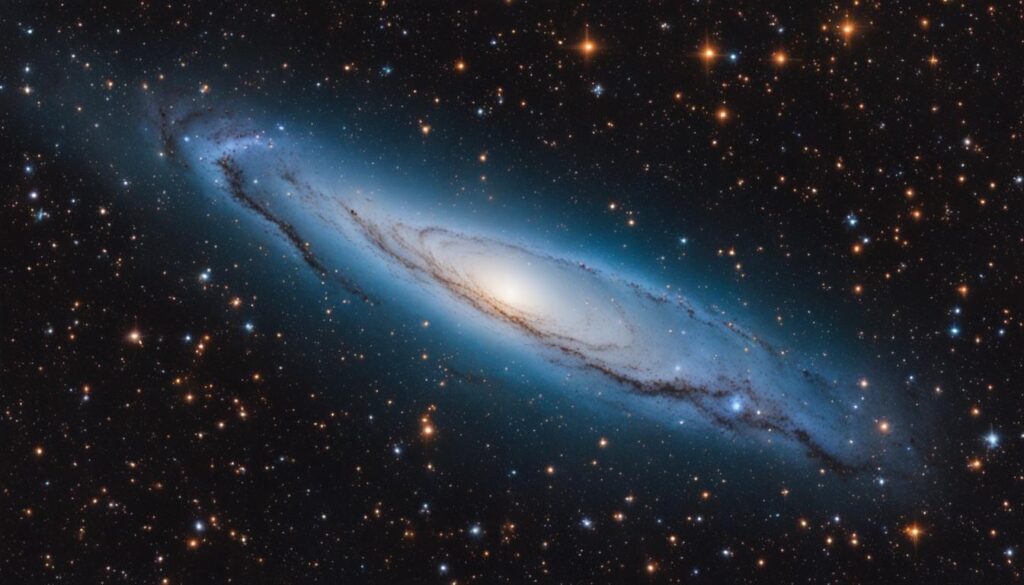
If we take a closer look at the Hubble image of Messier 79, we can see the mesmerizing beauty of the cluster. The densely packed stars form a dazzling tapestry, showcasing the immense diversity and evolution of stellar objects. The Hubble Space Telescope’s high-resolution capabilities allow us to discern individual stars within the cluster and study their characteristics in detail.
“The Hubble image of Messier 79 provides a unique perspective on the cluster’s composition and structure. We can observe stars at various stages of their life cycles, from young, hot blue stars to mature, Sun-like stars, and even aging red giants. This wealth of information helps us unravel the mysteries of star formation, evolution, and stellar populations within globular clusters.”
The Hubble observations of Messier 79 contribute to our understanding of the cluster’s formation and evolution. By analyzing the colors, brightness, and spatial distribution of the stars, astronomers can infer valuable insights about the cluster’s age, metallicity, and interactions with its surroundings. These observations also enable us to compare Messier 79 with other globular clusters, expanding our knowledge of the diverse stellar systems present in the universe.
The Hubble Space Telescope continues to be an invaluable tool for studying celestial objects like Messier 79. Its ability to capture detailed and high-resolution images allows us to explore the wonders of deep space and unravel the secrets of the cosmos.
Unusual Location and Possible Origins
Messier 79, also known as M79 or NGC 1904, stands out not only for its unique appearance but also for its unusual location in the sky. Unlike most globular clusters, which tend to be found near the galactic center, M79 is located on the opposite side of the sky from the galactic center.
There are several hypotheses to explain this unusual positioning. One possibility is that Messier 79 formed in a high-density region of stars, allowing for its creation in a distant location from the galactic center. Another intriguing possibility is that this globular cluster originated from an unusual dwarf galaxy that is currently merging with the Milky Way.
The concept of Messier 79 originating from the Canis Major Dwarf Galaxy gains credibility based on its location and interaction with our own galaxy. The Canis Major Dwarf Galaxy is currently experiencing a close encounter with the Milky Way, and the position of Messier 79 suggests that it may have been pulled from its original galaxy during this merger.
Investigating the unusual location of Messier 79 offers valuable insights into the origins and evolution of this globular cluster, as well as its connection to other galactic structures. Further research and observations can help unravel the mysteries surrounding its formation and position in the sky.
Conclusion
Messier 79, located in the southern constellation Lepus, is a captivating globular cluster that offers a glimpse into the wonders of our universe. Its unique position in the sky and its connection to the Canis Major Dwarf Galaxy make it a fascinating object for astronomers and stargazers alike. With its dense core, variable stars, and intricate structure, Messier 79 provides valuable insights into stellar populations, galactic interactions, and the evolution of our galaxy.
Exploring Messier 79 allows astronomers to delve into the mysteries of deep space and witness the celestial beauty of our galaxy. The observations and studies conducted on this cluster contribute to our understanding of the vastness and complexity of the universe we inhabit. From the mesmerizing blizzard of stars captured by the Hubble Space Telescope to its unusual location on the opposite side of the sky, Messier 79 continues to inspire awe and ignite curiosity.
As we peer into the depths of Messier 79, we gain a deeper appreciation for the intricacies of the cosmos. Its dense core, bursting with tightly packed stars, hints at the potential for core collapse, similar to other globular clusters. The presence of variable stars within Messier 79 provides valuable clues about its age and evolution, shedding light on the processes that shape these stellar communities.
In summary, Messier 79 is a captivating globular cluster that challenges our understanding of the universe. Its unique characteristics, relationship with the Canis Major Dwarf Galaxy, and scientific observations contribute to our knowledge of stellar populations, galactic interactions, and the evolution of the cosmos. As we continue our exploration of the universe, Messier 79 stands as a testament to the astounding beauty and complexity that awaits us in the depths of space.
FAQ
What is Messier 79?
Messier 79, also known as M79 or NGC 1904, is a globular cluster located in the southern constellation Lepus.
Where is Messier 79 located?
Messier 79 is located in the constellation Lepus, in the southern part of the sky.
What are the characteristics of Messier 79?
Messier 79 is classified as a V-class (V) globular cluster. It has an apparent magnitude of 7.7 and an apparent dimension of 8.7 arcminutes. The cluster has a metallicity of -1.55 dex and an estimated age of 11.7 billion years. It is home to around 150,000 stars, mostly red giants.
What is the relationship between Messier 79 and the Canis Major Dwarf Galaxy?
Messier 79 is believed to be part of the Canis Major Dwarf Galaxy, which is currently undergoing a close encounter with the Milky Way. The cluster’s location suggests it originated from the Canis Major Dwarf Galaxy and is now being pulled apart by the gravitational forces of the Milky Way.
What does the color-magnitude diagram of Messier 79 reveal?
The color-magnitude diagram of Messier 79 shows that most of the bright stars in the cluster are red giants. The diagram also reveals the presence of a red giant branch, a lower main sequence, and a horizontal branch.
Who discovered Messier 79?
Messier 79 was discovered by the French astronomer Pierre Méchain in 1780.
What is the density and core collapse of Messier 79?
Messier 79 has a dense core, classified as V-class density, suggesting it may have experienced a core collapse similar to other globular clusters.
Are there variable stars in Messier 79?
Yes, Messier 79 contains several known variable stars, including 10 RR Lyrae type variables, which exhibit regular changes in brightness over time.
What has the Hubble Space Telescope revealed about Messier 79?
The Hubble Space Telescope has captured stunning images of Messier 79, showing the intricate details and colors of the stars within the cluster.
Why is the location of Messier 79 considered unusual?
Messier 79’s location on the opposite side of the sky from the galactic center is considered unusual for a globular cluster, and it may have formed in a high-density region of stars or originated from an unusual dwarf galaxy merging with the Milky Way.
What is the conclusion about Messier 79?
Messier 79 is a fascinating globular cluster known for its unique position, dense core, variable stars, and intricate structure. The observations and studies of this cluster contribute to our understanding of stellar populations, galactic interactions, and the evolution of the universe.



